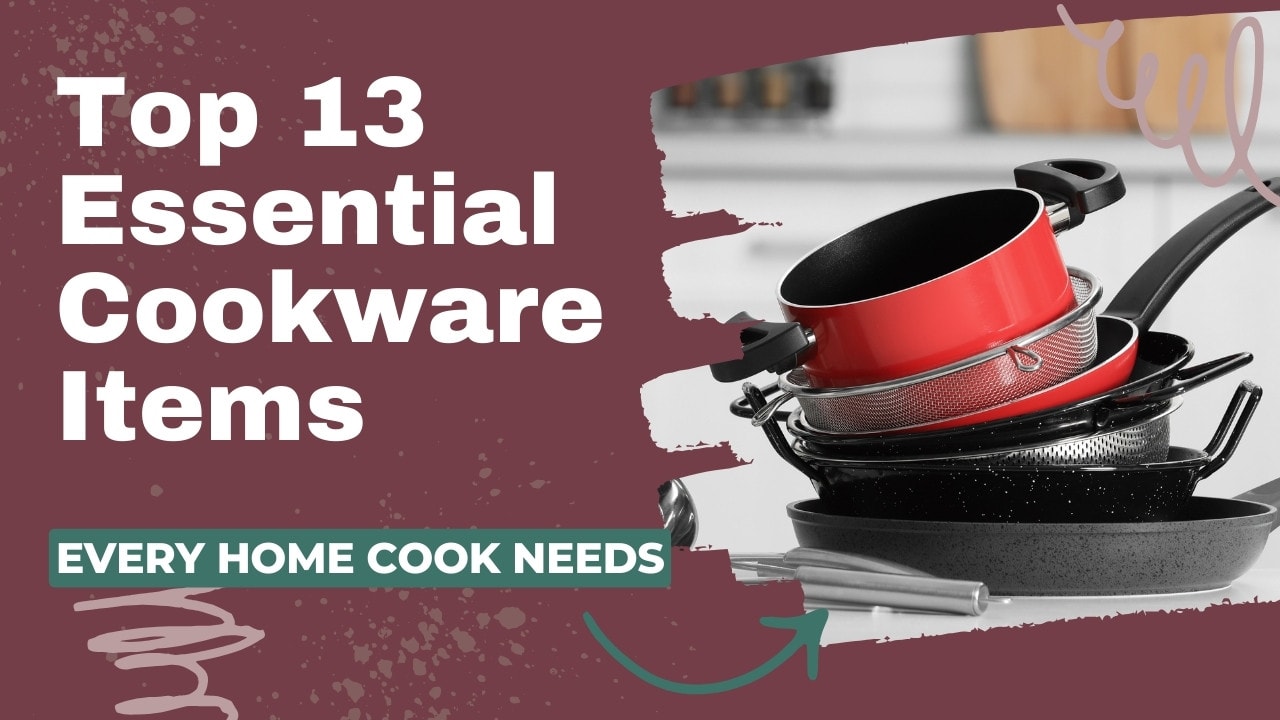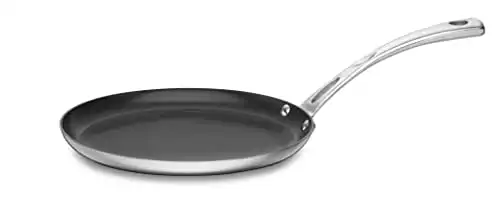Yes, I’ll admit it: I have a cookware problem!
I feel like every time I am introduced to a new kitchen gadget, I want to go out and buy a new piece. But what cookware do you actually need for a versatile home kitchen? Which cookware items are essential, and which are a waste of money?
In this article, I’m going to take you through the 13 essential cookware items that I, as a chef, believe you need in your kitchen and give product recommendations for each of them.
How Can You Tell What Cookware is Essential?
Each pot and pan has its own specific uses, and I feel like the material needs to correspond with those uses. For example, although you can buy a Dutch oven that’s ceramic, or cast iron, or stainless steel, or even aluminum – but some of those materials perform a lot better than others for the things you’d usually cook in a Dutch oven.
Throughout this list, I’ve chosen to recommend specific materials for each pan that I think will optimize its performance.
What Pots and Pans Does Every Kitchen Need?
When I was first moving out and starting a home with my partner, I really could have done with a list like this. It would have made creating our wedding registry much easier and more useful.
So, here are the 13 essential cookware items everyone needs in their kitchen:
1. Nonstick Fry Pan or Skillet
This is a multi-use pan that can be used for shallow frying, searing, and stir-frying. I particularly like these pans for cooking eggs and other sticky foods that need an easy release. Many brands have options that are suitable for most cooktops, including induction, so they are very versatile. Although most nonstick pans are hand wash only, the coating means they’re very easy to clean up.
I prefer to go for a nontoxic ceramic nonstick option with a hard anodized aluminum base because of its fast heating. A 10-inch frying pan is my ideal size. I find 12-inch doesn’t always fit my burners, and 8-inch can be a little small.
2. Cast Iron Skillet
You can’t go wrong with cast iron for a versatile, everyday frying pan. I cook my sticky and acidic foods in my nonstick frying pan, but everything else I cook in my cast iron. My favorite thing to use it for is searing a juicy steak.
Raw cast iron needs to be seasoned regularly to prevent rust and create a nonstick surface. It takes some work, but it’s totally worth it compared to how versatile and durable these pans are. You can pick up an excellent quality cast iron skillet for an affordable price, and it should last a lifetime.
Like the nonstick skillet, I like a 10-inch frying pan, but a 12-inch is also sufficient.
3. Omelet/Crepe Pan
This pan is far more versatile than it may seem. Not only can you use it to cook omelets or pancakes, but it’s also perfect for making tortillas. Basically, it’s ideal for anything you want to pan-fry that requires you to flip it. The lowered sides make it easy to turn small pancakes or fritters without breaking them.
I always go for nonstick crepe pans made from either aluminum or stainless steel with an aluminum or copper core for more even heat. Be careful to use only a silicone spatula when flipping to prevent scratching the pan.
4. Large Stock Pot
Stock pots are workhorse pots that are perfect for making soups, stocks, and boiling pasta. It’s also your best friend when you need to cook in large quantities.
My ideal stock pot is 8 qt and 3mm thick with tall sides. This balance allows you to cook a lot at once without the pot being too heavy. A stock pot doesn’t need to be nonstick, so I prefer to use one made from uncoated stainless steel. It’s very durable, nontoxic, and can withstand high heat on the stovetop or in the oven, so it’s the perfect choice.
5. Saute Pan
Some may think that a saute pan isn’t that useful, but I must politely disagree. Some dishes require the accessibility of a frying pan but with slightly higher sides to prevent sauces or stir-fried ingredients from spilling out. A saute pan is the perfect solution.
The height of the pan sides makes this pan ideal for shallow frying or stir-frying. But my favorite thing to make in a saute pan is a sauce that needs to be reduced. If I want a sauce to reduce quickly, I use a saute pan to increase the surface area.
6. Straight Sided Saucepan
Despite the name, saucepans are useful for more than just sauces. You can also deep fry, boil, saute, and poach in it. The depth is ideal for candy making, but it’s also great for making smaller portions of soup and stew. All of this just goes to show how versatile a saucepan is.
I prefer saucepans with straight sides because they contain food better than flared edges. When it comes to materials, I recommend 3 or 5-ply stainless steel because it has even heat distribution and can withstand high temperatures.
7. Individual Nonstick Frying Pan
Before I owned one of these small frying pans, I didn’t think they were that useful, but now I use mine all the time! Saying that, if you have a large family, you might not use these as often as a smaller single or two-person household might.
These small pans are perfect for toasting spices and nuts, frying individual eggs, or making single or two-serving sides like sauteed spinach. If I can avoid having to clean up a whole frying pan for such a small task, I will, and a small pan like this is perfect for the job.
8. Enameled Cast Iron Dutch Oven
Dutch ovens are super versatile, so you can start a dish on the stovetop and transfer it straight to the oven to finish cooking. It’s great for slow cooking, making stews and soups, braises, baking bread, and roasting meats.
Enameled cast iron is the best material for Dutch ovens because it has superior heat retention and is safe at high temperatures. But it’s key to buy from reputable brands like Staub, Lodge, and Le Creuset so you know they have been third-party tested for lead. All these brands have large ranges so that you can choose the capacity according to household size. I have a whole product round-up for you to peruse to find the perfect Dutch oven for you.
It’s worth mentioning there are some health concerns around enameled cast iron, but I have a full article answering all your questions about its safety.
The Staub is the most powerful oven of the three we tested, best at searing, braising, and bread baking. Its flat lid is designed to drip steam back into the pot.
9. Casserole Dish
Whether you bake large desserts or prefer a savory casserole or mac and cheese, a large rectangular casserole dish is vital in your kitchen. Besides baking, casserole dishes are also helpful for heating things up in the microwave or oven. You can even take them straight from the oven to your table for serving.
I like ceramic, stoneware, or glass casserole dishes because they have great heat retention and create an even heat to cook your dish. They’re usually dishwasher safe, which means clean-up is a breeze. Most casserole dishes are oven and fridge-safe, so you can store your leftovers in it afterward.
10. Grill Pan
I can’t resist a great steak with the signature bar marks of a good grill pan!
Grill pans are square pans with a series of bars on the surface. These bars char the surface of the protein or vegetable to add a smokey, caramelized flavor to the dish. These pans are best for grilling up meat, vegetables, and seafood.
I would choose an oven-safe grill pan so you can transfer from the stovetop to the oven when cooking dishes like large steaks. Also, be on the lookout for one that is safe to use on the outdoor grill because those are even more versatile.
11. Stainless Steel Roaster
There’s nothing quite like a family Sunday roast, which is why I think a great roaster is a necessity. These pans consist of a rack that fits into a rectangular dish. The roast sits on the rack, so there is even heat the whole way around the meat while it cooks. The dish below catches juices for you to make gravy with. You can also roast potatoes in this base.
I prefer stainless steel roasters because they can safely withstand high heat for a long period. It’s also dishwasher safe, so it’s easy to clean up when you’re done.
12. Bakeware
Every keen baker needs a selection of bakeware that you can use to bake a variety of creations like muffins, cupcakes, bread, cookies, and cake. The baking trays can also be used for cooking savory dishes like crumbed chicken or roast potatoes.
Aluminum is the best material for bakeware because it heats quickly without hot spots, so your bakes rise evenly every time. My advice is to look for a set with everything you need. Bonus points if it includes a cooling rack. But if you are on a budget, you can buy each piece as you need them.
13. Carbon Steel Wok
Yes, you can stir-fry in a frying pan, but it will never be the same as when you use a wok. The conical shape allows you to move the food freely around the pan even while using high heat. It’s perfect for making quick but healthy meals that are packed with veggies. I use mine most often for my signature egg-fried rice.
I prefer a carbon steel wok because it heats evenly all the way up the sides. It’s also much lighter than cast iron, so it’s easier to handle.
Helpful Cooking Accessories
Along with these essential pots and pans, these are some helpful cooking accessories that I think every well-stocked home kitchen needs.
Conclusion
If you have these 13 pieces of essential cookware in your kitchen, you’ll be able to make any dish you like using the perfect pan for the job. I hope this list has helped you figure out how to make your kitchen more well-rounded and streamlined.
Now, it is time for you to take stock of your cookware and see what you might be missing! Don’t forget to add some of the useful accessories to go with your pots and pans. If you have any questions, be sure to leave them below, and we will get back to you.






















